Abstract
In industrial equipment containing hydraulic lines for power transmission, the lines have boundary conditions defined by components such as pumps, valves, and actuators located at the ends of the lines. Sudden changes in any of the boundary conditions may result in significant pressure/flow dynamics (fluid transients) in the lines that may be detrimental or favorable to the performance of the equipment. Accurate models for line transients are defined by the exact solution to a set of simultaneous partial differential equations. In this paper, analytical solutions to the partial differential equations provide Laplace transform transfer functions applicable to any set of boundary conditions yet to be specified that satisfy the requirements of causality. Analytical solutions of these partial differential equations from previous publications are reviewed for cases of laminar and turbulent flow for Newtonian and a class of non-Newtonian fluids. This paper focuses on a method for obtaining total system analytical models and time domain solutions for cases in which the end-of-line components can be modeled with linear equations for perturbations relative to pre-transient flow conditions. Examples with pumps, valves, and actuators demonstrate the process of coupling equations for components at the ends of a line to obtain total system transfer functions and then obtain time domain solutions for outputs of interest associated with system inputs and load variations.
1. Introduction
When modeling the dynamics of systems containing fluid transmission lines as internal components, the effects of fluid transients in the lines on the performance of the system may be very dependent on the system input frequencies and the dynamics of the components attached to the ends of the lines [1,2,3,4,5,6,7,8,9]. These end-of-line components define the boundary conditions for the mathematical models for the fluid transients in the line and must be considered when modeling the dynamics of the total system. The approach taken when formulating a total system model depends on the end objective to be achieved. For simulation studies of systems with end-of-line components not easily or accurately modeled with small perturbation linearized equations, methods using lumped-parameter wave-based approximations for the line fluid transients may be the desired approach [10].
For total system analytical model formulations for end-of-line components that can be linearized and expressed in terms of the boundary variables for perturbations relative to pre-transient flow conditions, use of the exact analytical solution to the partial differential equations may be the desired approach, which is the focus of this paper [11,12,13]. This approach generates exact rational polynomial transfer functions applicable to time domain solutions for either deterministic or stochastic inputs. The resulting transfer functions can be used to do total system modal analyses, generate eigenvalues for design specifications based on stability and control, perform frequency domain analyses, and easily perform time domain studies related to system performance for specified external system inputs.
Having these equivalent transfer functions enables one to perform time domain simulations and analyses without having to decide which terms in infinite series formulations to include and without having to figure out how to revise the series to achieve the correct DC gain [14]. In addition, this method eliminates the need to deal with the complexities of infinite order inverse Laplace transforms [15] and avoids the need to redo each method-of-characteristics numerical solution for each change in boundary conditions and external inputs [16,17].
As has been explained, the exact solution to the partial differential equations for a particular line is infinite order in the frequency domain and very much a function of the line boundary conditions, which are defined by the end-of-line components. Thus, it is important to note that a total system model consisting of components and possibly additional lines will also be infinite order. The objective of this paper is to explain and demonstrate the process of simultaneously formulating total system model transfer functions and then obtain limited order equivalent transfer functions that include the dominant system modes and accurately account for potential input and/or disturbance frequencies, while at the same time having the correct DC gain [18]. A comprehensive derivation of the all-encompassing transfer function matrix for the fluid transients in a line is included in Appendix A.
2. Materials and Methods
Consider the schematic of a fluid transmission line shown in Figure 1.

Figure 1.
Schematic of a fluid transmission line with the input and output variables.
The boundary conditions for the line in Figure 1 are defined by the pressure variables and flow rate variables shown on the schematic. Analyses of the fluid transients in a line often focus on variables such as shear stress and pressure at different locations in the line. In this paper, however, the focus is on the effects of the fluid transients interacting with components such as pumps, valves, and actuators at the ends of the line. Such components define the boundary conditions at the ends of a line. By analytically solving the partial differential equations in terms of yet to be specified boundary conditions, it is possible to obtain transfer function equations applicable to any set of boundary conditions that meet the requirements of causality. This approach is summarized in a survey paper [1] on modeling techniques for fluid transients in smooth circular lines using frequency domain analytical solutions for a variety of assumed complexities in the model for the line and fluid properties. Equation (1) is a matrix representation of the equations from this reference for the analytical solution of the ‘dissipative model’, which includes viscosity and heat transfer effects in the model for fluid transients in lines with Newtonian fluids.
Equation (1) has been proven to be experimentally accurate for laminar mean flow conditions and over a limited turbulent mean flow range [19]. The hyperbolic Bessel functions in Equation (1) can be expressed in terms of infinite order product series for identifying dominant modes, resonant frequencies, and damping ratios [8].
Previous publications document reformulations of Equation (1) for turbulent flow [12,13] and for a certain class of non-Newtonian fluids [20,21,22,23,24]. A review of the derivation of these reformulations is presented in Appendix A. In all cases, the reformulations fit the normalized small perturbation format shown in Equation (2).
The perturbation variables in Equation (2) are associated with changes (transients) relative to pre-transient steady-flow conditions. In Equation (2), the pressure perturbations have been normalized by dividing by the pre-transient steady-flow pressure differential between the ends of the line, . The flow rate perturbations have been normalized by dividing by the pre-transient steady-flow rate through the line, . The normalized Laplace variable, , in Equation (2), indicates that time has been normalized.
In Equation (2), the Darcy–Weisbach friction factor equation for smooth pipes has been used to represent the pressure loss in the line. For Reynolds numbers less than 2000, the friction factor is assumed to be , corresponding to laminar flow. For Reynolds numbers greater than 4000, the Blasius empirical formula for turbulent flow, the friction factor is . The term in Equation (2) accounts for additional losses due to turbulence. It is based on the equations for the friction factor and defined in Equation (3), which is derived in Appendix A.
It is important to note that for the Reynolds number transition range from 2000 to 4000, the value for the friction factor is not clearly defined [25]; however, the two formulas for the friction factor are somewhat close in the transition range and give the same value for the friction factor at the Reynolds number of 1187.6. Hence, for software formulations where the pre-transient Reynolds number is not known in advance, Equation (3) does provide a transition formula for computer coding. This approach is like the smooth continuous formulation for the transition range used in [10].
As explained in Appendix A, for pre-transient turbulent flow, n is an integer typically between 1 and 10 corresponding to the required distribution of flow resistance due to turbulence along the line. The recommended value for n is based on convergence of the oscillation decay rate [12]. The recommended value for n has been found to increase as the Reynolds number increases in the turbulence range to relatively large numbers. Typically, n is increased by trial and error until additional decay rate convergence is essentially no longer improved. This process is demonstrated in one of the examples included in this paper.
Since Equation (2) is applicable to laminar or turbulent pre-transient flows with Newtonian or a certain class of non-Newtonian fluids, it is convenient to reformulate and express Equation (2) in an all-encompassing simplified format to use for any application, i.e.,
It is important to note that for values of n > 1, the terms in Equation (4) are defined only after raising the matrix in Equation (2) to the nth power.
3. Results
There are four variables in the two equations in Equation (4), and . Thus, additional equations, considering the requirements of causality, associated with the boundary conditions must be specified to complete the analytical solution for a specified total system. The process of adding additional equations associated with the boundary conditions defined by the end-of-line components is demonstrated in the examples that follow. It is important to note that the inclusion of these particular examples is not intended to imply that these particular systems have never been introduced and analyzed previously. Instead, it is assumed that most readers will already be familiar with the specific modeling equations in each case, enhancing the understanding of the method of using the solution matrix and procedure for transitioning from the frequency domain to the time domain.
3.1. Example 1—Water Hammer
This example is likely a case where the fluid transients have a detrimental effect on system components [26,27,28,29,30]. Suppose the pressure at the left end of the line is constant, then . In this case, solving the two equations in Equation (4) gives
The transfer function is the frequency domain infinite order analytical solution typically used to model the fluid transients (water hammer) due to sudden changes in the flow The transfer function in Equation (5) can be used to generate a time domain solution for given the time history of . In water hammer studies, a typical assumption is that instantly decreases from the pre-transient flow rate to 0; that is, is a negative step function from 1 to 0 [16].
For laminar or relatively low levels of turbulence, n = 1 can be assumed [12,13]; in this case, the transfer function in Equation (5) can be written as shown in Equation (6).
When working with an infinite order transfer function, it is convenient to first obtain a finite order approximation for the transfer function. This can be accomplished using product series for hyperbolic and Bessel functions [1,8]; this approach has been proven to be most difficult when it comes to satisfying the low frequency gain associated with steady-state conditions. A more simple and direct approach for obtaining finite order approximations is by approximating the frequency response of the infinite order transfer function over a specified frequency range using an inverse frequency algorithm [14]. This approach is commonly used in system identification algorithms to obtain equivalent linear transfer functions matching the actual frequency response over a finite frequency range. Transfer function approximations must match both the magnitude and phase parts of the frequency response. As will be demonstrated, an inverse frequency algorithm achieves this goal.
To generate the water hammer time domain solution for , the recommended first step is to obtain a frequency response plot of . The choice for the range of frequencies in the frequency response should consider the mode frequencies of the system and the input frequencies. Theoretically, a step change consists of frequencies from 0 to thus, for water hammer studies, the maximum frequency should be increased by trial and error until convergence representing the desired degree of no change is achieved. The second step will be to use an inverse frequency algorithm to obtain a finite order approximation for the frequency response over the specified range of frequencies. An example of the results using an inverse frequency algorithm is shown in Figure 2, Figure 3 and Figure 4 for a water line 37.23 m in length, with a 22.1 mm diameter, and with a pre-transient Reynolds number of 5600. These line dimensions and pre-transient flow conditions are associated with experimental data [17,31] used in the verification of the analytical solutions for turbulent flow [12].
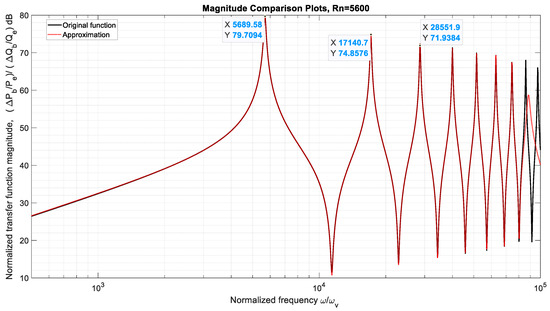
Figure 2.
Magnitude comparison of the frequency response of the inverse frequency linear transfer function approximation with the exact frequency response of the water hammer transfer function in Equation (6) for turbulent flow conditions.
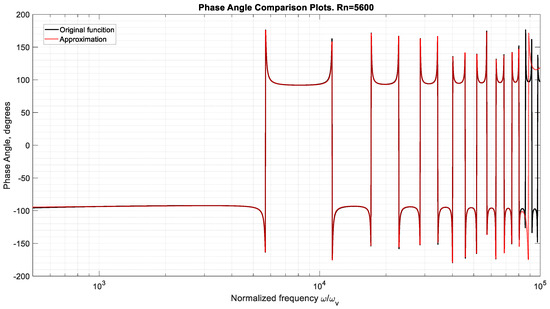
Figure 3.
Phase angle comparison of the inverse frequency response approximation with the exact frequency response of the water hammer transfer function in Equation (6).
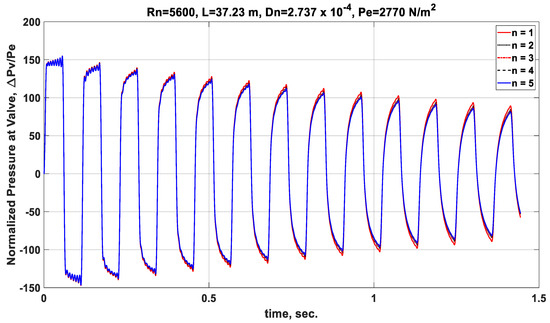
Figure 4.
Normalized pressure upstream of the value following valve closure demonstrating the pressure surge and wave frequency in the line and demonstrating the insensitivity to the number ‘n’ for this relatively low level of turbulence.
Referring to the magnitude plots in Figure 2, it is of interest to note that the input specification to the inverse frequency algorithm was to obtain a match over the normalized frequency range from 10−11 to 8 × 104; the minimum value 10−11 was chosen to calculate the DC gain near the correct value of 1 and the maximum value 8 × 104 chosen to accurately include at least seven second order dominant modes. For purposes of resolution, the minimum normalized frequency shown on the graph is 500 even though 10−11 was used in the algorithm. Also, note that the first three normalized resonant frequencies and peak values have been accurately identified with data tips. For example, at the normalized resonant frequency of 5689, the amplification of the sinusoidal pressure amplitude is The order of the transfer function approximation was chosen to be 19 in order to obtain a good fit over the specified frequency range. It is very important to note the near perfect frequency response match (dotted lines) out to the designated upper frequency of 8 × 104. An accurate match of the phase plots over the frequency range is confirmed in Figure 3.
An important advantage of using an inverse frequency algorithm to generate a rational polynomial transfer function is that follow-up computer code can be used to generate time domain plots for specified inputs such as a step change associated with a water hammer. Typical results are shown in Figure 4 for 5 for different values of ‘n’. Recall that ‘n’ defines the distribution along the line of the additional losses due to turbulence. Validation with experimental results revealed that ‘n’ may need to be increased to an integer greater than 1 until decay rate convergence is confirmed [12]. A comparison of the plots reveals that ‘n’ = 1 would be sufficient for this low level of turbulence since increasing the value does not essentially change the decay rate of the oscillatory response. As shown in Figure 4, following valve closure, the initial pressure surge, due to water hammer, peaks at about 150 = 4.155 × 105 N/m2.
3.2. Example 2—Lines with Pumps and Valves
Consider the schematic in Figure 5 of a line with a pump and a valve on the ends of the line. For this example, the passage area through the valve may be a function of time. For the pump, the output flow or pressure may be a function of time.

Figure 5.
Schematic of a line with a pump and valve.
Assume the flow through the valve is defined by the orifice equation with variable area and coefficient The nonlinear orifice equation that models forward or reverse flow is
Considering that the transfer function matrix in Equation (4) pertains to small perturbations relative to the pre-transient flow conditions, linearizing Equation (7) is possibly justified. Linearizing Equation (7) by taking the partial derivatives of the right side of Equation (7) about the pre-transient steady-flow conditions gives
To maintain consistency with the line transfer function equations, the pressure and flow variables are normalized by the equation for pre-transient steady flow through the line, i.e.,
The dimensionless parameter q represents the ratio of the pre-transient linearized valve resistance to the line steady-flow resistance, i.e., . Equations (4) and (9) contain 6-normalized perturbation variables, , , , , and , i.e.,
Thus, to complete the solution, one or more of the variables must be designated as input(s) and/or additional equations added. Consider the examples in the following section.
3.2.1. Case 1—Constant Flow from Pump with Changing Valve Area
Suppose changes in the valve area, is designated to be an input. Assume the pump has a fixed displacement with a constant output flow, , and the value output pressure is constant, If the output of interest is , then Equations (10)–(12) simplify to give the desired transfer function equation, i.e.,
Time domain plots of for different valve area changes can be generated once the transfer function in Equation (13) is approximated by a ratio of finite order rational polynomials. The steps for achieving the finite order transfer function and then generating a time domain solution for are the same as the steps used in generating Figure 4. In this case, the input can be any function of normalized time. It is important to note that the eigenvalues of the finite order transfer function reveal the resonant frequencies of the line; the input frequencies associated with changes in the valve area should be well below the eigenvalue frequencies to avoid potentially damaging pressure pulsations in the line associated with the fluid transients.
3.2.2. Case 2—Constant Valve Area with Changing Flow from a Variable Displacement Pump
This is a case where fluid transients may be desired and are likely to improve the performance of the system. Pumps are often used to force non-Newtonian fluids into downhole fissures in rock formations for oil and gas production. Pulsating flow rates from variable displacement pumps at resonant frequencies of the pressure transients in lines can enhance the performance of the system significantly. Theoretically, the resonant frequencies correspond to the resonant peaks on a frequency response. In practice, the resonant frequencies are determined by monitoring the pump output pressure, which will also peak at the resonant frequencies. The transfer function for perturbations in the downhole flow rate can be obtained from Equations (10)–(12). Assuming is specified to be an oscillating input and and , Equations (10)–(12) simplify to
The frequency response of the transfer function in Equation (14) is shown in Figure 6.
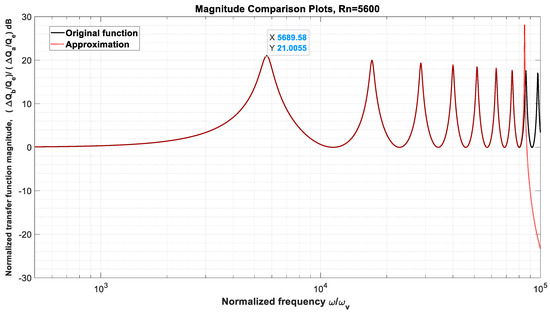
Figure 6.
Frequency response of the transfer function in Equation (20) for q = 10.
As with previous transfer functions derived in this section, the transfer function in Equation (14) is infinite order. As shown in Figure 6, a frequency response of this transfer function with q = 10 reveals that the first mode resonant frequency occurs at a normalized frequency of 5689 with a dynamic gain of 21 dB. Thus, for a sinusoidal flow rate out of the pump at this resonant frequency superimposed on a mean flow, the amplitude of the sinusoidal output flow rate perturbations at the end of the line will be times larger than the input amplitude. The results and accuracy of the inverse frequency algorithm are also shown in Figure 6; having an approximation for the transfer function enables one to generate time domain plots of for any other pump output flow rate specifications such as pulses, etc.
3.3. Example 3—Rotary Actuator Controlled by a Variable Displacement Pump
A variable displacement pump is used to power and control the speed of a hydraulic motor (rotary actuator) [32]. A schematic of the system is shown in Figure 7.

Figure 7.
Schematic of a rotary actuator speed control system.
The rotation speed, of the pump input shaft is assumed to be constant. The rotation direction and speed of the motor is determined by the direction and magnitude of the flow in the lines, which is determined by the pump displacement control lever. The significance of the fluid dynamics and flow losses in the lines are functions of the length and diameter of the lines and the frequencies of the input and the load torque . The variables labeled on the schematic indicate the positive direction of the flows corresponding to counterclockwise rotation of the motor and clockwise torque representing the load on the motor shaft opposing the rotation of the motor. Most likely, it would be desirable for the input frequencies from the pump and/or load torque to be well below the resonant frequencies of the total system, which are defined by the fluid transients coupled with the load dynamics.
The following derivation formulates the transfer function for the total system, which provides the dominant eigenvalue resonant frequencies, which should be significantly lower than the frequencies of changes in the swash angle and/or load torque. The pump displacement is proportional to the swash plate angle ; thus, the flow from the pump in terms of the pump shaft angular velocity is
The flow through the motor is proportional to the motor displacement , i.e.,
The torque equation on the motor shaft is
where is the rotational inertia of the load, is a viscous damping coefficient, and is the motor torque coefficient.
Laplace transforming Equations (15)–(17) and then rewriting in small perturbation normalized format gives
Using Equation (4) for line ‘a’ and for line ‘b’ (see Figure 7), we obtain the normalized perturbation equations for the fluid transients in the lines, i.e.,
Assuming no leakage, we can write
In Equations (18)–(24), there are two input variables, and , and there are nine unknowns, , , , , , , , , and . Thus, it is possible to solve for the transfer functions for any of the unknown variables. For example, suppose that the output of interest is the perturbation in the motor speed ; this variable can be rewritten in normalized Laplace format, i.e.,
Eliminating all of the unknowns except from Equations (18)–(24) gives
There are two transfer functions in Equation (26) for the inputs and . Thus, the time history of the rotational speed of the motor, considering the fluid transients, can be obtained for any input specifications, deterministic or stochastic, once the transfer functions have been approximated by ratios of finite order polynomials, as demonstrated in the following example.
Assume an industrial excavator system with the following hydraulic system design specifications:
- Required peak motor torque: 5000 Nm
- Desired pre-transient motor speed: 10 RPM
- Pump peak pressure: 250 bar
- Pump speed: 1600 RPM
- Mass moment of inertia:
- Viscous damping coefficient:
Assume the fluid and line properties are
A pre-transient motor flow of corresponds to a Reynolds number of 170.
The frequency response for the load variation transfer function in Equation (26) and a 15th order transfer function approximation are shown in Figure 8 and Figure 9 for a matching normalized frequency range of 1 to 2600. Note the near perfect accuracy of the approximation, both magnitude and phase, over the specified frequency range and out to approximately 3000.
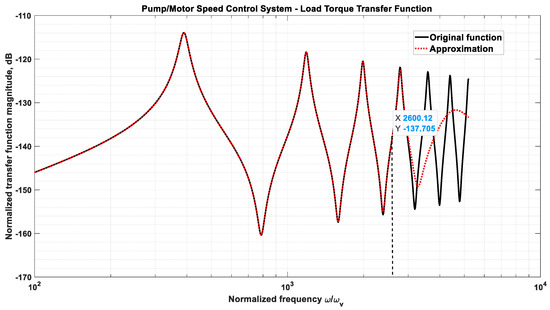
Figure 8.
Normalized frequency response magnitude of the transfer function in Equation (26) compared to a 15th order rational polynomial approximation obtained using an inverse frequency algorithm.
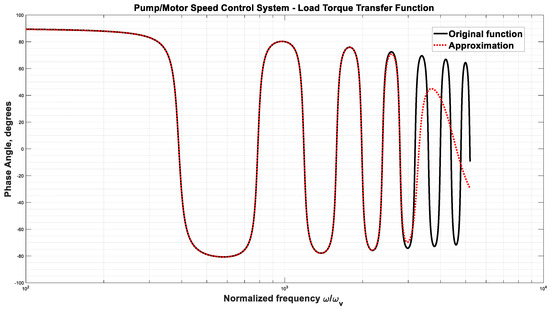
Figure 9.
Normalized frequency response phase angle of the transfer function in Equation (26) compared to a 15th order rational polynomial approximation obtained using an inverse frequency algorithm.
Examination of Figure 8 reveals the effects of the transmission line dynamics on the total system transfer function. That is, the transmission lines produce lightly damped changes to the motor RPM at the resonant frequencies of the total system. The choice of a 15th order approximation out to a maximum normalized frequency of 2600 was simply a trial-and-error test to gain insight into the system modes. Thus, knowing a range for potential input frequencies and the number of transfer function mode frequencies in that frequency range, it is possible that a much lower transfer function approximation would be sufficient for design and analysis studies of this system, as long as the DC gain of 0 is preserved.
Insight into potential reduced order approximations is gained by examining the normalized eigenvalues shown in Table 1 for the 15th order system. Limiting the normalized frequency range of the approximation to 2600 for a 15th order transfer function approximation has resulted in five first order modes and five second order modes. It should be obvious why previous research studies attempting to use product series equations for the terms in the transfer function matrix have found it very difficult to know which 1st order modes to include [8].

Table 1.
Eigenvalues of the 15th order total system model.
Insight into potentially reducing the order of the approximation can also be gained by generating a unit step response of the 15th order transfer function. Consider the step response shown in Figure 10.
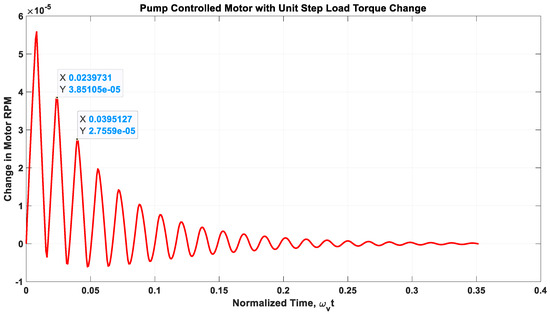
Figure 10.
Unit step response of the 15th order transfer function approximation.
As shown in Figure 10, the normalized period of the oscillation (0.0395 − 0.02397) = 0.0155, which corresponds to a normalized frequency of 404. So, possibly by limiting the normalized frequency range to 700 instead of 2600 would it be possible to obtain a good fit with a lower order transfer function. The results for a ninth order transfer function approximation over a normalized frequency range of 1 to 700 are shown in Figure 11, Figure 12 and Figure 13.
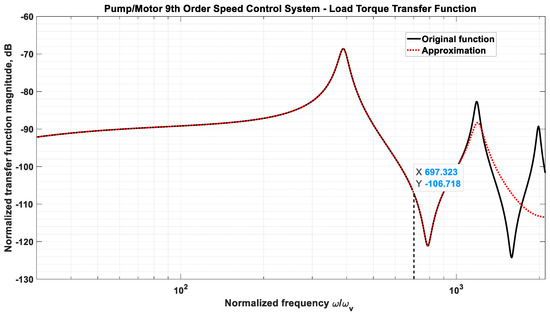
Figure 11.
Normalized frequency response magnitude of the transfer function in Equation (26) compared to a ninth order rational polynomial approximation obtained using an inverse frequency algorithm out to a normalized frequency of 700.
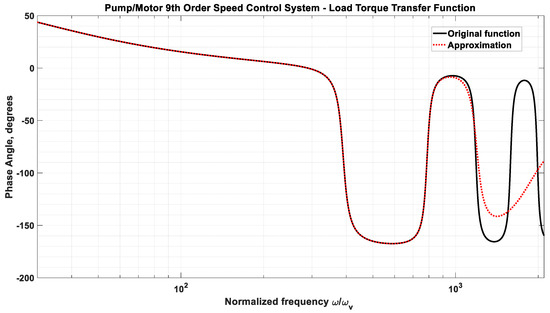
Figure 12.
Normalized frequency response phase angle of the transfer function in Equation (26) compared to a ninth order rational polynomial approximation obtained used an inverse frequency algorithm out to a normalized frequency of 700.
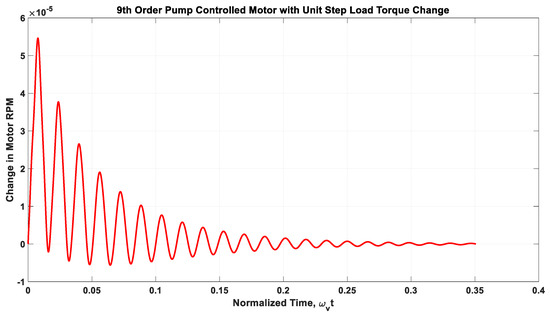
Figure 13.
Unit step response of the ninth order transfer function approximation.
The step response shown in Figure 13 for the 9th order transfer function approximation is essentially identical to the response in Figure 10 for a 15th approximation, and the DC gain of zero has been preserved.
One final demonstration is to generate the normalize time response of the ninth order transfer function for a stochastic input defined by a power spectral density of for . The result shown in Figure 14 is typical of systems subject to noise and stochastic inputs associated with random load changes. Simulation results such as those shown in Figure 14 can be generated on most simulation platforms that can handle previously recorded data inputs from measurements.
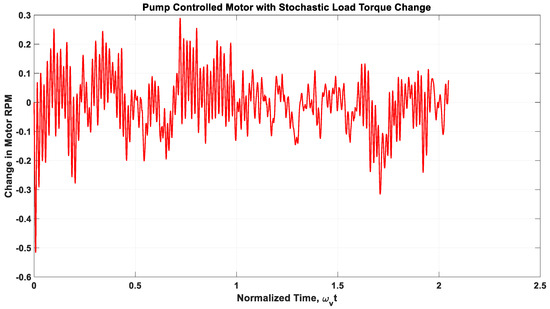
Figure 14.
Normalized time response of the ninth order transfer function for a stochastic input defined by a power spectral density.
4. Discussion
The results generated in this paper utilized the MATLAB R2024b platform. However, the results can be achieved with any software platform and computer languages that contain signal processing and system identification functions. Experience has revealed that the desired order of the transfer function approximation must take into account at least two times the number of second order modes observed in the necessary frequency range, plus additional unobserved first order modes that may exist. It is important to note that generation of an equivalent transfer function approximation will always be a trial and error process, starting with the frequency response of the infinite order system transfer function, which can be used to determine the frequency range for the approximation considering the input frequencies and an estimate of the order of the transfer function based on the observed modes. Experience has revealed that the desired order of the numerator should be set to one less than the order of the denominator, since unneeded coefficients will essentially end up being very small numbers close to zero.
An additional desired specification for the software platform is to be able to compute and plot time responses directly without having to reenter the transfer function approximation. For stochastic inputs, the platform must have a Fast Fourier transform function and statistical analysis functions. MATLAB mfiles used to generate the examples in this paper can be obtained by contacting the author directly.
5. Conclusions
The concept of ‘inverse frequency’ is to obtain an equivalent rational polynomial numerator and denominator transfer function approximation of a total system frequency response over a specified range of frequency response data for the total system. This approach is particularly applicable to the functions in Equation (4), which are obviously linear since the hyperbolic Bessel functions could have been expressed using infinite order product series [1,8]. In previous research, however, to obtain the transfer function approximations using the series formulations has proven to be very difficult, since it is never obvious which first order modes need to be included in order to not only maintain the low frequency accuracy associated with the DC gain but to also include critical first order modes at higher frequencies [8,18].
Accurate models for fluid transients in lines are defined by a set of simultaneous partial differential equations. As demonstrated in Appendix A, the analytical solution to these partial differential equations is obtained without having to specify specific details about components at the ends of the line. This is very desirable and provides significant versatilities to the analysis of the interaction of fluid transients with different end-of-line components that can be linearized for perturbations relative to pre-transient flow conditions. Examples demonstrating the method for model formulations and conversion from the frequency domain to the time domain have been presented. The analytical solution in Equation (4) is applicable to either laminar or turbulent pre-transient flow for Newtonian and a specific class of non-Newtonian fluids.
Funding
This research received no external funding.
Data Availability Statement
The MATLAB code used to produce the results in this paper can be obtained from the author.
Acknowledgments
The author is most appreciative of the feedback and suggestions from the reviewers that have led to a much-improved publication.
Conflicts of Interest
The author declares no conflicts of interest.
Nomenclature
| Wave velocity, (m/s) | |
| Element in transfer function matrix in Equation (4) | |
| A | Short notation for terms defined in Equation (A33) |
| Pre-transient steady-flow valve area, m2 | |
| Change in valve area, m2 | |
| Normalized valve area change, | |
| Constant in the Blasius friction factor equation, | |
| Viscous friction coefficient, (Nms/rad) | |
| Ratio of Bessel functions, | |
| C | Orifice discharge coefficient divided by |
| Motor torque coefficient, (rad) | |
| Coefficient defined by terms in Equation (A42) associated with boundary conditions | |
| Coefficient defined by terms in Equation (A43) associated with boundary conditions | |
| Pump swash angle volume coefficient, (m3/rad2) | |
| Motor displacement, (m3/rad) | |
| Pump displacement, (m3/rad) | |
| Dimensionless dissipation number, | |
| Modulus of elasticity of pipe material, (N/m2) | |
| Function used in solving the partial differential equations | |
| Symbol used for a transfer function | |
| Dimensionless parameter in Equation (14) | |
| J | Notation for |
| Motor and load mass moment of inertia, (Nms2/rad) | |
| Bessel function of order 0 | |
| Bessel function of order 1 | |
| Length of fluid line, | |
| Short notation for terms in Equation (A26) | |
| Number of line sections in the turbulence model | |
| Dimensionless parameter | |
| Pressure at the upstream end of the line, (N/m2) | |
| Change in the pressure , (N/m2) | |
| Pressure at the upstream end of the ith line segment, (N/m2) | |
| Pressure at the downstream end of the line, (N/m2) | |
| Change in the pressure , (N/m2) | |
| Pressure at the downstream end of the line segment, (N/m2) | |
| Short notation for pre-transient pressure differential , (N/m2) | |
| Valve downstream pressure | |
| Q | Pre-transient dimensionless flow resistance ratio, |
| Volumetric flow rate at upstream end of line, (m3/s) | |
| Change in the flow rate , (m3/s) | |
| Flow at the upstream of the line segment, (m3/s) | |
| Volumetric flow rate at downstream end of line, (m3/s) | |
| Change in the flow rate , (m3/s) | |
| Flow at the downstream of the line segment, (m3/s) | |
| Pre-transient steady state flow rate in line, (m3/s) | |
| Radial position from the center of the fluid line, (m) | |
| Internal radius of fluid line, (m) | |
| Laminar steady flow resistance in line, (Ns/m5) | |
| Reynolds number, | |
| Additional steady flow resistance in line associated with turbulence, (Ns/m5) | |
| Laplace variable | |
| Normalized Laplace variable, | |
| Time, (s) | |
| Normalized time, | |
| Thickness of pipe wall, (m) | |
| Motor load torque, (Nm) | |
| Change in Motor load torque, (Nm) | |
| Fluid velocity, function of and , (m/s) | |
| Pre-transient steady flow velocity, function of , (m/s) | |
| Laplace transform of , (m/s) | |
| Normalized Laplace transform of , | |
| Perturbation of | |
| Short notation for terms in defined Equation (A69) | |
| Axial position along the fluid line, (m) | |
| Transfer function matrix () element | |
| Dimensionless parameter defined by the terms in Equation (A19) | |
| Characteristic impedance of the line defined in, (Ns/m5) | |
| Impedance constant, , (Ns/m5) | |
| Equivalent bulk modulus, (N/m2) | |
| Motor speed, (rad/s) | |
| Pump speed, (rad/s) | |
| Axial position ratio, | |
| Propagation operator of line, | |
| Oldroyd-B retardation time constant, (s) | |
| Oldroyd-B relaxation time constant, (s) | |
| Normalized time constant | |
| Normalized time constant | |
| Dynamic viscosity for pre-transient steady flow, , (Ns/m2) | |
| Kinematic viscosity for pre-transient steady flow, (m2/s) | |
| Density for pre-transient steady flow, (kg/m3) | |
| Shear stress, function of and , (N/m2) | |
| Shear stress at wall for pre-transient steady flow, (N/m2) | |
| Normalized shear stress at wall, function of | |
| Perturbation of | |
| Frequency, (rad/s) | |
| First mode frequency obtained from eigenvalues, (rad/s) | |
| Viscous frequency, , (rad/s) | |
| Normalized frequency, | |
| Pump swash plate angle, (rad) |
Appendix A. Analytical Solution to the Partial Differential Equations Considering Potentially Non-Newtonian Turbulent Flow Conditions
Appendix A.1. Newtonian Fluids
The closed form Newtonian analytical model for laminar flow transient perturbations in circular lines has been documented, experimentally verified, and used successfully for more than 50 years [1]. The primary objective of this appendix is to review the extension of this model for transient perturbations in non-Newtonian fluids and then review the further extension of it for turbulent flow [12]. Specific details of these derivations are included in this paper since the end result is an all-encompassing transfer function matrix representing the foundation of the material in this paper. The partial differential equations for the momentum, continuity, energy, and state for the dissipative model for laminar flow in a horizontal smooth line are listed in Equations (A1)–(A3) [1]. The simplified isothermal versions of these equations for compressible liquids with only -direction axial flow are as follows
The axial velocity is a function of and ; is the pressure, which is assumed to be uniform at any specific ; is the stress tensor as a function of and ; is the pre-transient fluid density, and is the equivalent bulk modulus of the fluid, which is a function of the elasticity of the line walls and can be adapted to include the effects of entrained gas.
For Newtonian fluids and laminar flow, the well-known frequency domain solution to Equations (A1)–(A3) in terms of the normalized Laplace variable is shown in Equations (A4)–(A9) [1]. The details of this solution will be repeated in this appendix but with the addition of the non-Newtonian terms [4,5,6,7] and the impedance effects of turbulence [3]. This solution can be expressed in terms of normalized frequency using
where
where
The dimensionless parameter is indicative of the attenuation and distortion along a line. It is the ratio of the wave travel time along a line to a term indicative of transient decay [1,14]. For Newtonian fluids .
Appendix A.2. Extension of the Newtonian Analytical Model to Non-Newtonian Fluids
The well-known and widely accepted derivation for the Newtonian analytical model in Equation (A4) is repeated here, but as mentioned above, is expanded to include the Oldroyd-B stress tensor model [5,6,7,8,9], i.e.,
In Equation (A9), for , viscosity decreases (shear thinning) as transient frequencies increase. For , an increase in viscosity occurs as the frequency increases. For , the viscosity is constant, corresponding to a Newtonian fluid.
Combining Equations (A2) and (A3) gives
Laplace transforming Equations (A1) and (A10) assuming zero initial conditions and normalizing gives
Substituting Equation (3) for the Oldroyd-B shear stress model into Equation (A11) gives
Rearranging and collecting the terms in Equation (A13) gives
or
where
Equation (A15) is a Bessel equation with solution
where
The function is not a function of and will be defined by the boundary conditions at the ends of the line. Using Equations (A16) and (A18), the solution for can be written, i.e.,
Considering that there is no slip at , Equation (A20) gives
Thus,
Substituting Equation (A22) into Equation (A20) gives an equation for the velocity as a function of , , and , i.e.,
At this point in the derivation, the assumption will be made that the flow passage is a circular pipe with radius . Since the boundary conditions at the ends of the line will be in terms of the flow rates and pressures, it is convenient to compute the average velocity. Multiplying Equation (A23) by and then integrating and dividing by gives
where
Solving for in Equation (A12) and then taking the derivative with respect to gives
Taking the 2nd derivative of Equation (A25) with respect to gives
From Equation (A22)
Substituting Equation (A27) into Equation (A29) gives
Substituting Equation (A28) into Equation (A30) gives
Rearranging Equation (A31) gives the following equation
where
The solution to Equation (A32) is
where and are determined by the boundary conditions at the ends of the line, defined by the flow rates and pressures. Using Equation (A25), we obtain
The equations for the pressures require the use of Equation (A12) and the derivative of Equation (A25), i.e.,
Thus,
From Equation (A36)
From Equation (A40)
Thus, substituting Equations (A42) and (A43) into Equations (A37) and (A41) gives
or
where
Equation (A45) represents the non-Newtonian version of Equation (A4). It is of interest to note that Equation (A45) is identical to Equation (A4) except for the inclusion of the Oldroyd-B shear stress terms in and in the parameter in Equation (A48). Also, Equations (A46) and (A47) are identical in form to Equations (A7) and (A6), respectively. Setting makes ; so, Equation (A45) for non-Newtonian becomes identical to Equation (A4) for Newtonian.
Appendix A.3. Extension to Pre-Transient Turbulent Flow
For Newtonian fluid, Equation (A4) was extended to a model for pre-transient turbulent flow [12]. Since Equation (A45) is identical to Equation (A4) except for the inclusion of the non-Newtonian shear stress parameters in the parameters and , the extension of Equation (A4) to turbulent flow is applicable to the non-Newtonian model in Equation (A45). The extension to pre-transient turbulent flow is summarized here in order to clarify the derivations of equations for pre-transient turbulent normalized shear stress and normalized velocity, which are included in this appendix.
The pre-transient turbulent flow model is based on using the analytical model in Equation (A45) in series with a lumped resistance sized so that the resulting model for the line has the same steady-flow resistance as a smooth line with pre-transient turbulent flow [12]. To potentially improve the accuracy of the model for relatively large Reynolds numbers, the resistance is distributed along the line by dividing the line into n-sections. The schematic for such a multi-sectioned model is shown in Figure A1, where , , , and are intermediate pressures and flows.

Figure A1.
Line of length L with a lumped resistance at the end of each segment of length L/n.
The Blasius empirical model for the Darcy friction factor for smooth lines is utilized to establish the turbulent flow resistance . For Reynolds numbers up to 200,000 [12,13] in smooth lines with steady flow , the corresponding pressure differential between the ends of a horizontal line is
where
Denoting the steady-flow laminar resistance by , it can be shown that the additional resistance needed to match the total resistance for turbulent flow is given by
Using normalized perturbation variables representing pressure and flow changes from the pre-transient turbulent level, the resulting model for the transients in the line is [3].
where
and
It has been demonstrated that Equation (A52) for Newtonian fluids gives good agreement with water hammer experimental data and MOC solutions with values of n from 1 to 10 and Reynolds numbers up to 15,800 [12]. It has been demonstrated for water hammer simulations that a value of 10 is sufficient for decay rate convergence for Reynolds numbers out to 200,000 [4].
Referring to Equation (A52), it can be shown that if ; in computer code, this is the transition Reynolds number for which the Blasius and laminar flow friction factors are identical. It is also important to note that for = 1 and RT = 0, Equation (A52) gives the solution for pre-transient laminar flow in a horizontal smooth line.
References
- Goodson, R.E.; Leonard, R.G. A Survey of Modeling Techniques for Fluid Line Transients. ASME J. Basic Eng. 1971, 94, 474–482. [Google Scholar] [CrossRef]
- Manhartsgruber, B. Transmission Line Models for Fluid Power Hoses Identified from Measurement Data. Fluid Power Syst. Technology. 2024, 88193, V001T01A026. [Google Scholar] [CrossRef]
- Catania, G.; Sorrentino, S. Dynamical analysis of fluid lines coupled to mechanical systems taking into account fluid frequency-dependent damping and non-conventional constitutive models: Part 2—Coupling with mechanical systems. Signal Process. 2015, 50, 281–295. [Google Scholar] [CrossRef]
- Bordbar, M. Analytical Solution of Quasi-Two-Dimensional Method for Unsteady Transient Pressurized Pipe Flows in the Time Domain. J. Hyd. Eng. 2025, 151, 04025035. [Google Scholar] [CrossRef]
- Manhartsgruber, B. A Set of Benchmark Problems for Fluid Power System Simulation. Fluid Power Syst. Technol. 2022, 86335, V001T01A044. [Google Scholar] [CrossRef]
- Kogler, H.; Scheidl, R.; Schmidt, B.H. Analysis of Wave Propagation Effects in Transmission Lines due to Digital Valve Switching. Fluid Power Syst. Technol. 2015, 57236, V001T01A057. [Google Scholar] [CrossRef]
- Brunone, B.; Meniconi, S.; Capponi, C. The Damping of Pressure Peaks during Transients for Fault Detection in Pressurized Pipelines: An Expeditious and Manager-Oriented Diagnosis Procedure. J. Hydraul. Eng. 2023, 149, 02523002. [Google Scholar] [CrossRef]
- Hullender, D.A.; Healey, A.J. Rational Polynomial Approximations for Fluid Transmission Line Models. In Fluid Transmission Line Dynamics, Proceedings of the Winter Annual Meeting, Washington, DC, USA, 15–20 November 1981; American Society of Mechanical Engineers: New York, NY, USA, 1981; pp. 33–55. [Google Scholar]
- Urbanowicz, K.; Jing, H.; Bergant, A.; Stosiak, M.; Lubecki, M. Progress in Analytical Modeling of Water Hammer. J. Fluids Eng. 2023, 145, 081203. [Google Scholar] [CrossRef]
- Braun, R.; Nordin, P.; Ericson, L.; Viktor, L.; Krus, P.; Pettersson, M. Hopsan: An Open-Source Tool for Rapid Modelling and Simulation of Fluid and Mechatronic Systems. Fluid Power Syst. Technol. 2020, 83754, V001T01A047. [Google Scholar] [CrossRef]
- Bruhl, M. Analytical Solution for Laminar Water Hammer with Frequency-Dependent Friction. J. Fluids Eng. 2020, 144, 111302. [Google Scholar] [CrossRef]
- Hullender, D. Alternative Approach to Modeling Transients in Smooth Pipe with Low Turbulent Flow. ASME J. Fluids Eng. 2016, 138, 121202. [Google Scholar] [CrossRef]
- Hullender, D. Water Hammer Peak Pressures and Decay Rates of Transients in Smooth Lines with Turbulent Flow. ASME J. Fluids Eng. 2018, 140, 061204. [Google Scholar] [CrossRef]
- Wongopotorn, P.; Hullender, D.A.; Woods, R.L. Rational Polynomial Transfer Function Approximations for Fluid Transients in Lines. Fluids Eng. Div. Summer Meet. 2003, 36967, 2797–2804. [Google Scholar] [CrossRef]
- Urbanowicz, K.; Bergant, A.; Grzejda, R.; Stosizk, M. About Inverse Laplace Transform of a Dynamic Viscosity Function. Materials 2022, 15, 4364. [Google Scholar] [CrossRef] [PubMed]
- Bergant, A.; Zlatko, R.; Urbanowicz, K. Analytical, Numerical 1D and 3D Water Hammer Investigations in a Simple Pipeline Apparatus. Stroj. Vestn.-J. Mech. Eng. 2025, 71, 149–156. [Google Scholar] [CrossRef]
- Bergant, A.; Simpson, A.R.; Vitkovsk, J. Developments in Unsteady Pipe Flow Friction Modelling, ASCE. J. Hydraul. Res. 2001, 39, 249–257. [Google Scholar] [CrossRef]
- Hullender, D.A.; Woods, R.L.; Hsu, C.H. Time Domain Simulation of fluid Transmission Lines Using Minimum Order State Variable Models. In N: Fluid Transmission Line Dynamics 1983, Proceedings of the Winter Annual Meeting, Boston, MA, USA, 13–18 November 1983; American Society of Mechanical Engineers: New York, NY, USA, 1983; pp. 51–78. [Google Scholar]
- Regetz, J.D., Jr. An Experimental Determination of the Dynamic Response of a Long Hydraulic Line; National Aeronautics and Space Administration: Washington, DC, USA, 1960; Technical Note D-576.
- Hullender, D. Analytical non-Newtonian Oldroyd-B transient model for pre-transient turbulent flow in smooth circular lines. J. Fluids Eng. 2019, 141, 021303. [Google Scholar] [CrossRef]
- Bird, R.B.; Armstrong, R.C.; Hassager, O. Dynamics of Polymeric Liquids, 2nd ed.; Wiley: New York, NY, USA, 1987; Chapter 2; Volume 1. [Google Scholar]
- Oldroyd, J.G. Non-Newtonian effects in steady motion of some idealized elastic-viscous liquids. Proc. R. Soc. 1958, A 245, 278–297. [Google Scholar]
- Oldroyd, J.G. On the formulation of rheological equations of state. Proc. R. Soc. 1950, A 200, 523–541. [Google Scholar]
- McGinty, S.; McKee, S.; McDermott, R. Analytic Solutions of Newtonian and Non-Newtonian Pipe Flows Subject to a General Time-Dependent Pressure Gradient. J. Non-Newton. Fluid Mech 2009, 162, 54–77. [Google Scholar] [CrossRef]
- Garcia, F.J.G.; Alvarino, P.F. On the analytic explanation of experiments where turbulence vanishes in pipe flow. J. Fluid Mech. 2022, 951, A4. [Google Scholar] [CrossRef]
- Urbanowicz, K.; Di Nucci, C.; Sharma, B.K.; Ashok, K.; Kawiak, M.; Krajewski, S. Revisiting Yamaguchi-Ichikawa water hammer model. Chin. J. Phys. 2025, 94, 487–503. [Google Scholar] [CrossRef]
- Guse, F.; Pasquini, E.; Schmitz, K. Consideration of Air Bubble Dynamics in 1D Hydraulic Pipeline Simulation—Source Term Development and Verification Utilizing Transmission Line Theory. Fluid Power Syst. Technol. 2021, 85239, V001T01A002. [Google Scholar] [CrossRef]
- Vıtkovsky, J.P.; Lee, P.J.; Zecchin, A.C.; Simpson, A.R.; Lambert, M.F. Head-and Flow-Based Formulations for Frequency Domain Analysis of Fluid Transients in Arbitrary Pipe Networks. ASCE J. Hydraul. Eng. 2011, 137, 556–568. [Google Scholar] [CrossRef]
- Danes, L. The influence of line and fluid parameters on pressure ripple in hydraulic transmissions. SN Appl. Sci. 2020, 2, 1281. [Google Scholar] [CrossRef]
- Bayle, A.; Rein, F.; Plouraboue, F. Frequency varying rheology-based fluid-structure-interactions wave in liquid-filled visco-elastic pipes. J. Sound Vib. 2023, 562, 117824. [Google Scholar] [CrossRef]
- Adamkowski, A.; Lewandowski, M. Experimental Examination of Unsteady Friction Models for Transient Pipe Flow Simulation. ASME J. Fluids Eng. 2006, 128, 1351–1363. [Google Scholar] [CrossRef]
- Blackburn, J.F.; Reethof, G.; Shearer, J.L. Fluid Power Control; The M.I.T. Press: Cambridge, MA, USA, 1960; Lib. of Congress Catalog No. 59-6759; pp. 499–508. [Google Scholar]
Disclaimer/Publisher’s Note: The statements, opinions and data contained in all publications are solely those of the individual author(s) and contributor(s) and not of MDPI and/or the editor(s). MDPI and/or the editor(s) disclaim responsibility for any injury to people or property resulting from any ideas, methods, instructions or products referred to in the content. |
© 2025 by the author. Licensee MDPI, Basel, Switzerland. This article is an open access article distributed under the terms and conditions of the Creative Commons Attribution (CC BY) license (https://creativecommons.org/licenses/by/4.0/).